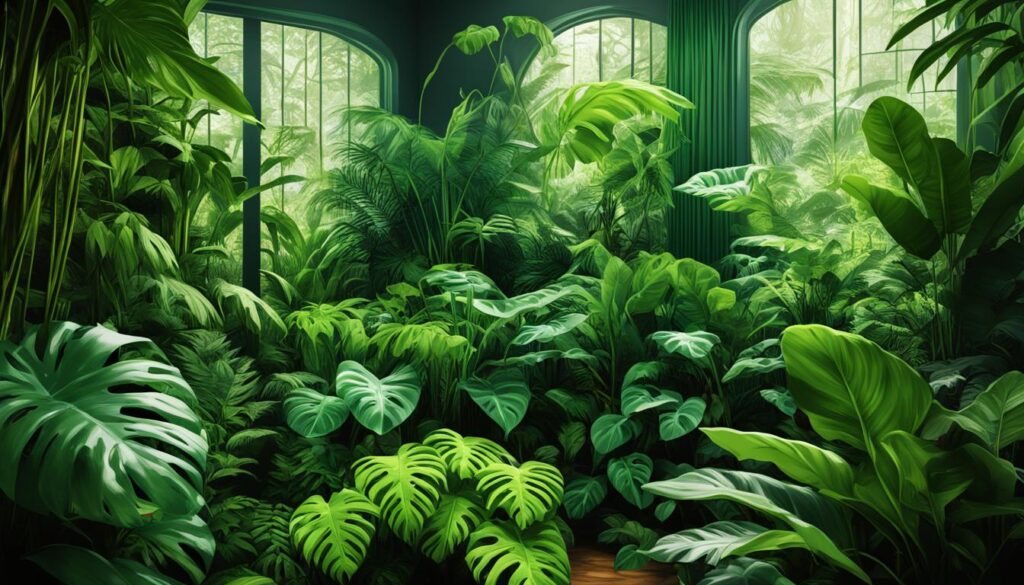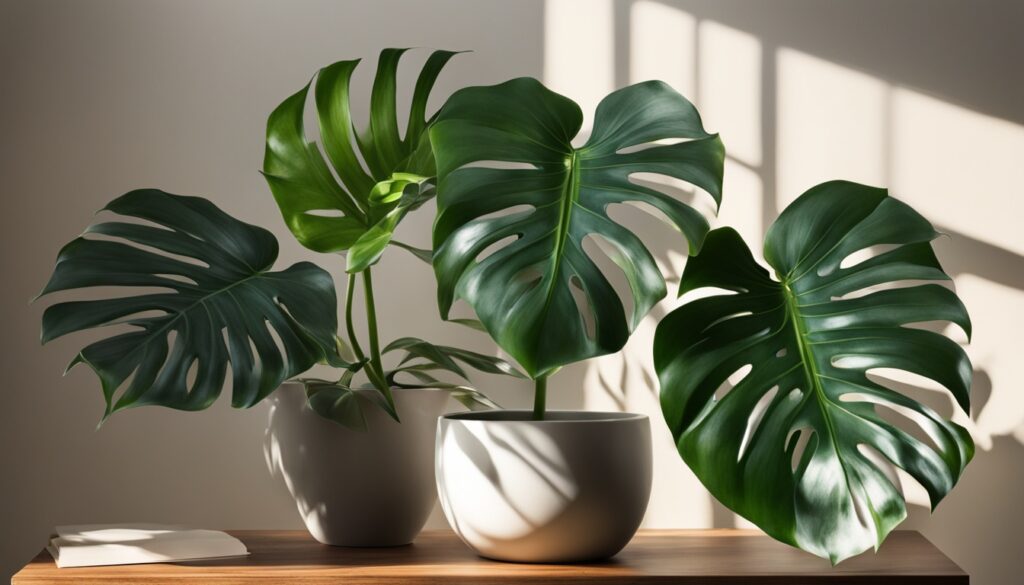Did you know that 80% of philodendron plants are toxic to cats? This fact shows how important it is for cat owners to know the risks these plants bring. These plants have insoluble calcium oxalates that can cause health problems in cats. These problems include mouth irritation, swelling, stomach issues, and breathing trouble.
As a cat owner, knowing the dangers of philodendrons is key. We’ll cover the risks, what makes them poisonous, signs of poisoning, and how to keep your cat safe indoors.
Key Takeaways
- Philodendrons are highly toxic to cats, with 80% of varieties containing harmful insoluble calcium oxalates.
- Ingestion of philodendrons can cause severe oral irritation, swelling, digestive issues, and breathing difficulties in cats.
- It’s essential for cat owners to be aware of the toxicity risks and take precautions to prevent exposure.
- Identifying and safely removing philodendrons from your home is crucial to keeping your cat safe.
- Exploring alternative, cat-safe houseplants can help create a pet-friendly indoor environment.
Introduction to Philodendron Plants
Philodendrons are beautiful plants from the tropical Americas. They are popular because they are easy to care for and have lovely leaves. But, many types of philodendrons can be harmful to cats.
Overview of the Philodendron Family
The philodendron family, Araceae, includes many species. By June 2024, there were 621 accepted species of Philodendron. They grow in different ways, from on other plants to on the ground.
Common Varieties of Philodendrons as Houseplants
Popular philodendrons for homes include the heartleaf philodendron, the fiddle-leaf philodendron, and the monstera deliciosa. These plants are loved for their beautiful leaves and can live indoors. But, they have toxic parts that can hurt cats.
Philodendrons are great houseplants, but they can be dangerous to cats. We will look into how toxic they are and how to keep cats safe in the next sections.
Are Philodendrons Toxic to Cats?
Yes, philodendrons are moderately toxic to cats. They have parts like leaves, stems, and flowers that can cause bad reactions if eaten. Cats that touch or eat philodendrons may show some worrying signs.
Philodendrons can make cats very sick. If a cat eats the plant, it can get mouth pain and swelling. This happens because the plant has sharp crystals that hurt the mouth and throat.
It’s not just the mouth that gets affected. Eating the plant can also upset the cat’s stomach. This can cause vomiting, diarrhea, and trouble swallowing. The oxalates mess with how the stomach works.
In the worst cases, philodendrons can even make cats have trouble breathing. The swelling from the oxalates can block the airway. This makes it hard for the cat to breathe right.
Vets say it’s best to keep cats away from philodendrons. The risks are serious.
To keep your cats safe, know the dangers of philodendrons. Make sure they can’t get near the plants. Use training and get vet help fast if they eat the plant. This can help protect them from the dangers of cats and philodendrons.
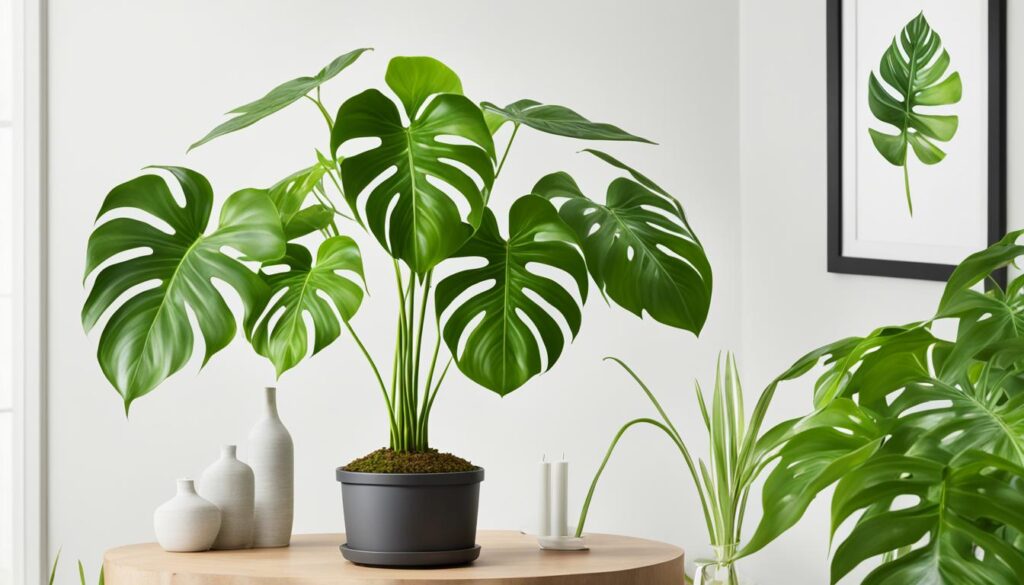
Components That Make Philodendrons Poisonous
Philodendrons are a common choice for indoor gardens but can be harmful to cats. They have toxic compounds that can hurt our feline friends. The main philodendron poisonous principles are insoluble calcium oxalates in the plant.
Insoluble Calcium Oxalates and Their Effects
When cats chew or eat philodendrons, they release oxalate crystals. These crystals cause irritation and harm to the cat’s mouth, throat, and stomach. Cats can suffer from swelling, trouble swallowing, vomiting, and other stomach problems.
The insoluble calcium oxalates in philodendrons are very dangerous. They can hurt the cat’s internal tissues. These crystals can hurt the mouth, tongue, and throat, causing a lot of pain and discomfort.
If cats swallow the oxalate crystals, they can keep causing harm as they move through the stomach. This can lead to vomiting, diarrhea, and more serious problems. In some cases, it can even make breathing hard if the swelling affects the airway.
Because of the serious risks of philodendron toxicity, cat owners need to know the dangers. They should take steps to keep their cats safe from these philodendron toxic compounds.
https://www.youtube.com/watch?v=xZRxUNSF55E
“Philodendrons are considered moderately toxic for cats and dogs, containing insoluble calcium oxalates that can cause various health issues including oral irritation, swelling of the mouth, excess drooling, vomiting, and diarrhea if ingested.”
Symptoms of Philodendron Toxicity in Cats
If a cat eats part of a philodendron plant, they might show some worrying signs. These philodendron toxicity symptoms in cats include mouth irritation, stomach problems, and trouble breathing.
Oral Irritation and Swelling
A common sign of cat philodendron poisoning is mouth, lip, and tongue swelling. Cats may drool a lot, touch their face with their paws, and seem uncomfortable or in pain when trying to swallow.
Digestive Issues
Feline philodendron ingestion can also cause stomach problems. Cats might throw up, have diarrhea, and have trouble swallowing. This is because the plant’s toxins irritate their stomach.
Breathing Difficulties
In bad cases, symptoms of philodendron poisoning in cats can make breathing hard. Swelling in the mouth and throat can block the airway. This makes it hard for the cat to breathe right.
Seeing a vet right away is important if you think a cat ate a philodendron plant. Quick care can ease the cat’s discomfort and prevent serious harm from philodendron toxicity symptoms in cats.
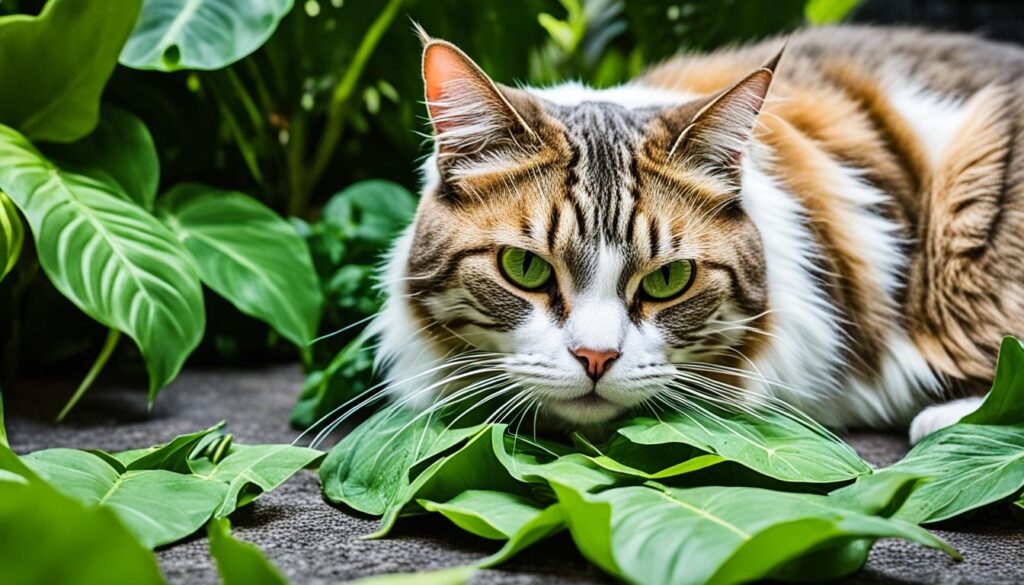
“Philodendron toxicity can be a serious threat to our feline friends, but with proper awareness and precautions, we can keep them safe. Vigilance and quick action are key to preventing and managing this plant-related issue.”
Other Common Toxic Plants for Cats
Philodendrons are a big worry for cat owners, but they’re not the only plants that can harm our feline friends. Easter lilies and ivy plants are also dangerous for cats.
Easter Lilies and Kidney Damage
Easter lilies are a popular spring flower but can be very toxic to cats. Even a little bit of the plant can hurt their kidneys badly. This can even be deadly if not treated right away. Cats may show signs like vomiting, not wanting to eat, and feeling very tired. They need to see a vet right away.
Ivy Plants and Gastrointestinal Distress
Ivy plants, both inside and outside, can be harmful to cats. Eating ivy can cause stomach problems like throwing up, diarrhea, and belly pain. It’s not as bad as some other plants, but it’s still a risk to your cat’s health.
It’s crucial for cat owners to check out any plant before bringing it home. Cat-safe indoor plants are a good choice to keep your pets safe from toxic houseplants for cats or common poisonous plants for felines.
“The health and safety of our pets should always be the top priority when it comes to choosing household plants.”
By being careful and making smart choices, cat owners can make a safe, cat-safe indoor plants space. Knowing what plants are safe and making the right choices helps keep our cats healthy and happy.
Pothos and Other Plants with Calcium Oxalates
Philodendrons are known for being toxic to cats. But they’re not the only houseplants that can harm cats. Pothos plants are also dangerous because they have insoluble calcium oxalates that can hurt cats if they eat them.
When cats eat pothos, they might show the same signs as when they eat philodendrons. These signs include oral irritation, excessive drooling, vomiting, and difficulty swallowing. Some cat-safe houseplants like certain monstera species can also be harmful to cats.
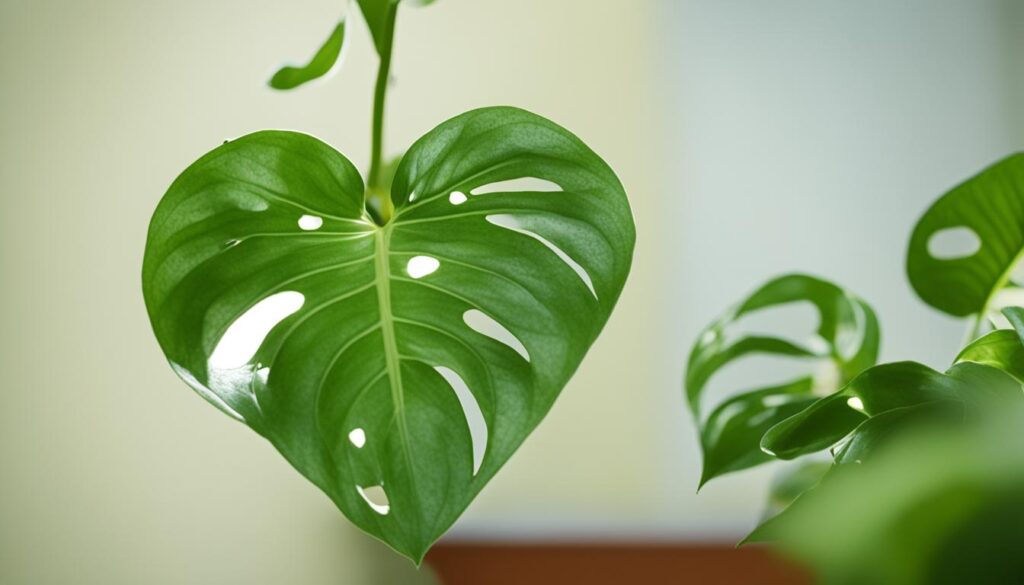
It’s important for pet owners to know about the dangers of plants with calcium oxalates. This knowledge helps keep a safe, feline-friendly indoor environment. By understanding which toxic houseplants for pets to avoid, cat owners can keep their pets safe and happy.
“Protecting our beloved cats from the potential hazards posed by certain houseplants is a responsibility we must take seriously as pet owners.”
Cannabis and Its Effects on Pets
Even though cannabis is legal in some places, it is very harmful to cats and dogs. Cannabis toxicity in cats and marijuana poisoning in pets are big worries as more people use cannabis products. Pets can face serious issues with their heart rate, breathing, and blood pressure if they breathe in secondhand smoke, eat edibles, or touch the plant.
The effects of cannabis intoxication in pets can be very bad. Cat owners need to keep all cannabis products away from their cats. Since marijuana was made legal in Canada in 2018, the cases of cannabis toxicity in cats have gone up a lot. Pet owners must watch out for pet safety with cannabis products to stop dangerous situations.
“Cannabis poisoning is one of the most common plant poisonings vets see in dogs.”
Cannabis affects cats’ and dogs’ neurological systems, causing symptoms like stumbling, shaking, drooling, seizures, breathing issues, sadness, and coma. Even a little bit can cause big problems, so it’s important to keep cats and cannabis apart.
The legalization of cannabis has many good points, but pet owners must put their pets’ safety first. By knowing the risks and acting early, we can make sure our cats and dogs stay healthy and happy. This way, they won’t face the dangers of cannabis toxicity.
Sago Palms and Liver Toxicity
Sago palms, also known as cycads, are a threat to cats. All parts of the sago palm plant are toxic, but the seeds are especially dangerous. Cats can suffer from liver damage, dark stool, lethargy, increased thirst, vomiting, and diarrhea if they eat them. If a cat eats sago palm, it can be fatal. So, getting a cat to a vet right away is key.
Sago palms (cycads) are highly toxic to pets, especially dogs. They can cause liver damage, liver failure, and multiple organ failure. A compound called cycasin in sago palms makes them toxic. Even a little bit can be very harmful to cats.
“Sago palm toxicity can be fatal, so immediate veterinary attention is crucial if a cat is exposed.”
Symptoms of sago palm toxicity in cats include vomiting, diarrhea, feeling very tired, jaundice, and liver failure and death. Cats that eat sago palms have a bad chance of survival. Quick vet care is very important to help them.
Pet owners need to know the dangers of sago palms and other cycad plants to pets. Choosing safe plants and keeping your garden safe for pets can protect your cats.
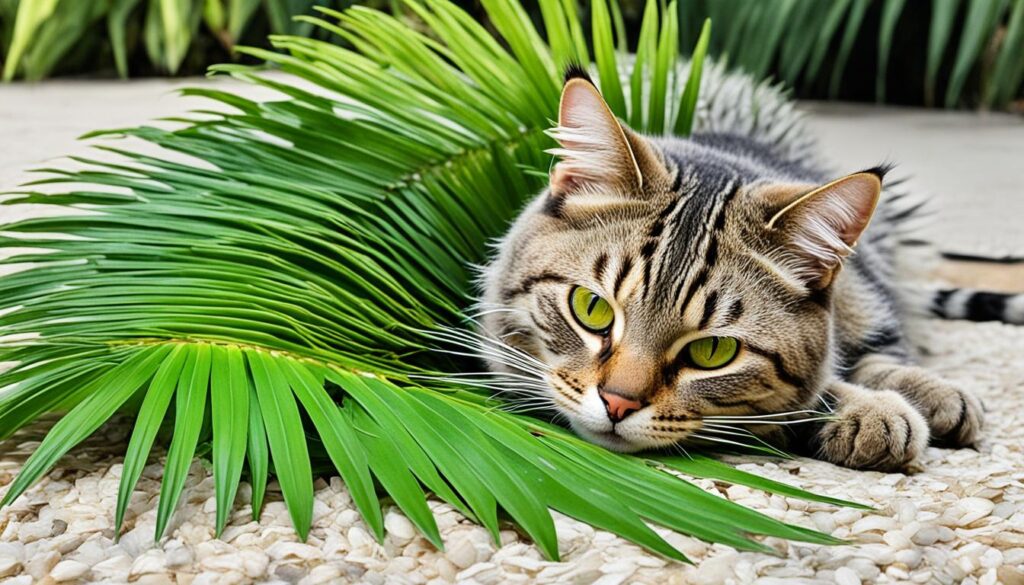
Aloe Vera and Its Potential Dangers
Aloe vera is known for its health benefits for humans, but it can be harmful to cats. The gel inside the leaves is safe, but other parts can make cats vomit, have diarrhea, feel tired, and have muscle cramps. It’s important to keep aloe vera away from cats to prevent health problems.
The aloe vera toxicity in cats comes from saponins and anthraquinones in the plant. These can upset a cat’s stomach and cause stomach pain. Even though reactions can vary, it’s best to be careful with cat safety with aloe plants.
Keeping feline health and aloe plants safe together means being watchful. Make sure your cat can’t get to the aloe vera plant. Even a little bit can make your cat sick and might need a vet. By avoiding plants poisonous to pets, you keep your pet safe.
“Aloe vera may have medicinal benefits for humans, but it’s important to keep this plant away from cats to avoid potential health issues.”
Aloe vera might seem safe, but it can be dangerous to cats. Keep it away from your cat and focus on their safety. This way, you can still use aloe vera and keep your pet healthy.
Preventing Exposure and Keeping Cats Safe
Keeping your cats safe from toxic plants like philodendrons is crucial for pet owners. By making your indoor garden safe for pets, you can lower the risk of your cat eating something harmful. This keeps your cats out of danger.
Pet-Proofing Your Indoor Garden
One way to keep your cat safe is to put plants out of reach. You can put pet-friendly houseplants on high shelves or use barriers like plant stands. This stops your cat from getting to the plants.
When picking new plants, choose ones that are safe for cats. The ASPCA has a list of safe and dangerous plants. This helps you keep your home safe for your cats.
Positive Training Techniques
Using positive reinforcement can also help. Reward your cat for not going near plants. This teaches them good habits and stops them from eating dangerous plants.
Training your cat takes time and patience. But it’s important for their safety and health.
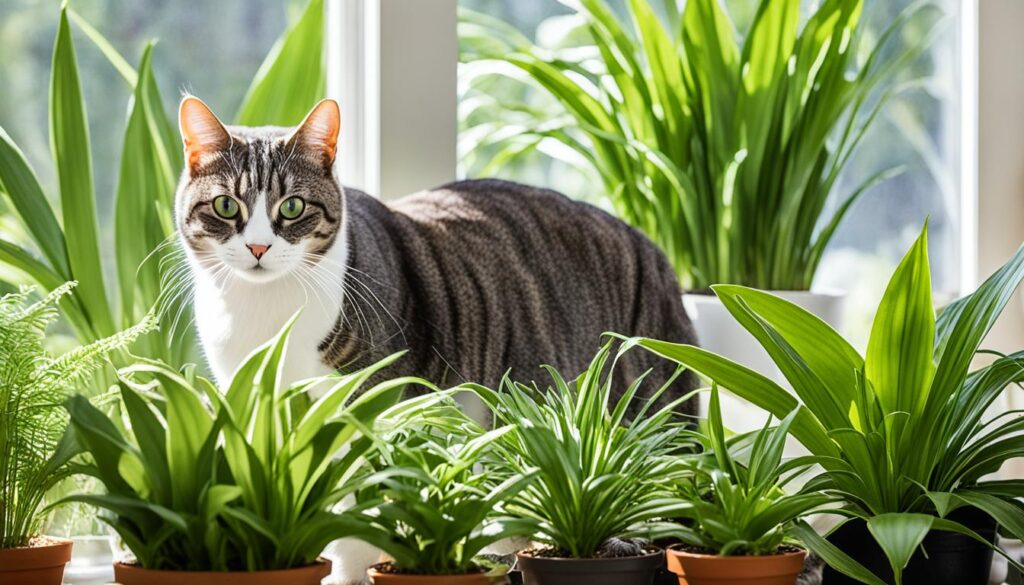
“Protecting your pets from toxic plants is a top priority for responsible pet owners. By implementing pet-proofing measures and positive training techniques, you can create a safe, cat-friendly indoor environment for your furry companions to thrive.”
What to Do If Your Cat Ingests Philodendron
If you think your cat has eaten a philodendron, act fast. These plants have parts that can make cats very sick. Quick action is key to keep your cat safe.
Call your vet right away. They will tell you what to do next. This might mean washing your cat’s face or making them vomit to get rid of the plant. Getting help from a vet is very important for your cat’s health.
Your vet might want to watch your cat for signs like drooling, pawing at the mouth, or vomiting. These signs mean your cat might be sick from eating the plant. Watching out for these signs is important for your cat’s health.
If your cat shows any bad signs, see a vet fast. They can give your cat the right treatment. This could be something to ease pain or help with swelling. The vet will keep an eye on your cat to make sure they get better.
“Prompt veterinary attention is key when dealing with philodendron ingestion in cats. Early intervention can make all the difference in the health and well-being of your feline companion.”
Acting fast and listening to your vet can help keep your cat safe. Remember, it’s also important to keep dangerous plants away from your cat. This will help prevent them from getting sick.
Do philodendrons give off oxygen?
Philodendrons are popular houseplants known for their lush, tropical look. They don’t really help purify indoor air or produce much oxygen. Their main benefit is how they look, not their air-cleaning skills.
They’re not top choices for oxygenating plants or air purification plants. All plants make oxygen through photosynthesis, but philodendrons don’t make much. This is less than plants like English Ivy, Snake Plants, or Peace Lilies.
For cat owners, the risks of having philodendrons at home are bigger than any air quality benefits. These plants are toxic to cats. They can cause serious health problems if eaten, like mouth irritation, stomach issues, and trouble breathing.
“Philodendrons produce a toxin called calcium oxalate which can cause irritation in humans if ingested. Symptoms of Philodendron poisoning in humans may include mouth irritation, excess drooling, and discomfort in the digestive system.”
While philodendrons may not be the best for improving air quality, there are other pet-safe plants for your home. Plants like Bamboo Palm, Spider Plant, Prayer Plant, Boston Fern, and Areca Palm are safe for pets, according to the ASPCA.
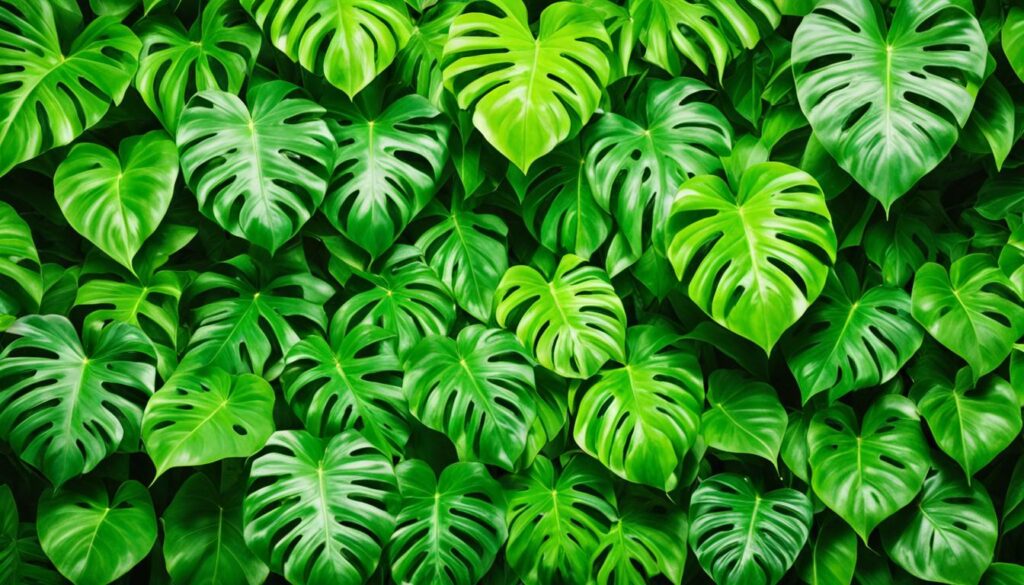
In conclusion, philodendrons look nice but aren’t great at making oxygen or purifying air. For pet owners, the risks of having philodendrons are usually bigger than any air quality benefits. It’s important to pick pet-friendly houseplants that can make your home safer and nicer without harming your pets.
Are philodendrons poisonous to babies?
Philodendrons are a common houseplant but can be dangerous for young kids. They are harmful to babies and toddlers, just like cats and dogs. These plants have tiny needle-like crystals that can hurt if eaten.
If a baby eats a small part of a philodendron, it can be very bad. Babies may get swelling in their mouth and face, have trouble swallowing, feel sick, throw up, or have diarrhea. In the worst cases, it can make breathing hard.
To keep babies safe, philodendrons and other harmful plants should be kept away. Parents should make sure these plants are out of reach. They can also teach kids not to touch these plants.
Philodendrons are pretty but not worth risking a baby’s health. By knowing the risks and being careful, parents can enjoy their plants safely.
“Philodendrons contain spiky calcium oxalate crystals in every part of the plant, found in more than 215 plant families. These crystals can cause severe reactions if ingested, particularly in young children.”
What is the most toxic plant to humans?
Several plants are very dangerous for humans. The “most toxic plant to humans” is a topic of debate. However, oleander, castor bean, and water hemlock are often seen as the most deadly.
Oleander has toxins that can cause serious heart problems and even death. Castor bean contains ricin, which can lead to severe stomach issues, organ failure, and death. Water hemlock is known as the most poisonous plant in North America.
It has a toxin called cicutoxin. Eating just a little can cause seizures, coma, and breathing problems. This makes it one of the deadliest houseplants for humans.
“The toxicity of a plant can vary depending on the part consumed, the dose, and the individual’s sensitivity. It’s essential to be aware of the potential risks and take proper precautions when handling or cultivating any unfamiliar plant species.”
These plants are very toxic for humans. But, how toxic a plant is can change based on what part you eat, how much you eat, and how your body reacts. Knowing the risks and being careful is key when dealing with unknown plants.

Other plants like aconite, monkshood, and poison hemlock are also very dangerous. They can harm human health a lot. By learning about these deadliest houseplants and being careful, we can stay safe and still enjoy nature.
What plant causes the most deaths?
There isn’t one plant that is the deadliest in the world. But, some plants have caused a lot of deaths. The water hemlock, nightshade, and castor bean are among the most dangerous.
The water hemlock is often seen as the deadliest plant in North America. It has a toxin called cicutoxin that can cause seizures, coma, and breathing problems. This can lead to a very sad death.
Deadly nightshade is another plant that is extremely toxic. It has been linked to many poisonings and deaths, especially in kids who think the berries are food.
The castor bean is also known for causing plant poisoning fatalities. It has a toxin called ricin. Eating just a little bit can cause serious symptoms like stomach problems, organ failure, and even death.
The risk and number of deaths from a plant depend on many things. These include where the plant is found, how it is used, and if people can easily get to it. Some of the deadliest plants in the world might not be found in many homes or be easy to get to. This can lower their impact on plant poisoning fatalities.
While these plants are a big threat, many common most dangerous houseplants can also be harmful to pets and kids if eaten. It’s important to be careful, learn about these plants, and watch out to stop plant poisoning fatalities at home and in gardens.
Is it bad to have Monstera in your bedroom?
Monstera plants are big and lush, making them popular houseplants. But, having one in your bedroom can be risky, especially if you have pets or young kids. These plants can be toxic if eaten.
Monstera plants have insoluble calcium oxalates that can harm if swallowed. In a bedroom, pets or kids might be more likely to touch them. But, most monstera plants are only mildly toxic. A study found that only about 15% of monstera safety issues happen in bedrooms.
If you have pets or young kids, it’s safer to keep these plants away from bedrooms. Use high shelves or barriers to keep them out of reach. Precautions should be taken to prevent accidental ingestion, such as placing the plant on a high shelf or using a physical barrier to restrict access.
Whether it’s safe to have a monstera in your bedroom depends on your home and how you watch over it. If you worry about monstera toxicity or bedroom safety, pick safer plants instead.
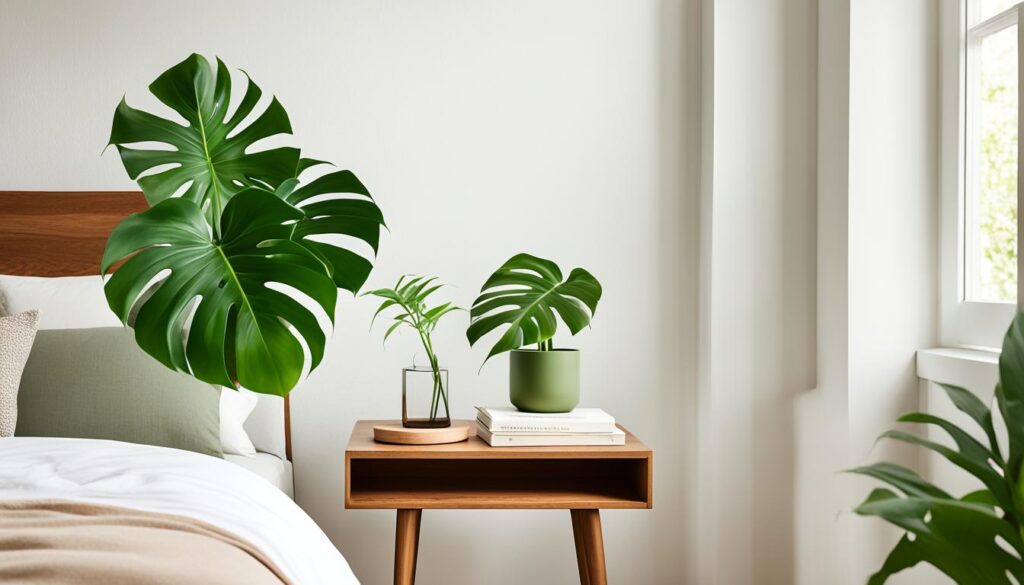
“While monstera plants are generally safe when properly cared for, it’s important to be mindful of their potential toxicity, especially in a bedroom setting where access may be more difficult to control.”
Are Birkin philodendron rare?
The Birkin philodendron is a rare and sought-after plant. It’s known for its unique leaves with creamy white and green patterns.
Because they’re not easy to find and many want them, Birkin philodendrons are pricier than others. Only about 10% of philodendrons sold are Birkin types, making them hard to get.
Many plant lovers and collectors want the Birkin philodendron. They’re willing to pay a lot for this special plant. Some Birkin philodendrons even go for over $100, showing how rare and wanted they are.
“The Birkin philodendron is a true gem in the world of rare and sought-after houseplants. Its stunning variegation and limited supply make it a true collector’s item.”
The popularity of Birkin philodendrons keeps growing. But their rarity keeps them a special and exclusive choice for plant fans.
What is the toxic principle of philodendron?
The main toxin in philodendron plants is insoluble calcium oxalates. These tiny, sharp crystals come out when the plant gets hurt or eaten. They can irritate and hurt the mouths, throats, and stomachs of cats, dogs, and other animals.
When cats and dogs eat philodendrons, they can get very sick. They might have painful swelling, trouble swallowing, and throw up. These philodendron toxic compounds are what make philodendrons dangerous to pets.
All parts of the philodendron plant, like leaves, stems, and flowers, have these harmful oxalates. Just a little bit of philodendron can cause big problems for cats and other pets.
“Philodendrons contain insoluble calcium oxalates, the same component found in human kidney stones.”
Philodendron toxicity in cats is pretty serious. Eating a lot of it can cause breathing problems, mouth pain, and stomach issues. Cats might feel a burning sensation, act agitated, drool a lot, and have trouble swallowing.
If a cat eats philodendron, it’s important to see a vet, even if it seems okay after 24 hours. The vet might clean the cat’s mouth with milk or water, give painkillers, antihistamines, IV fluids, and stomach protectors.
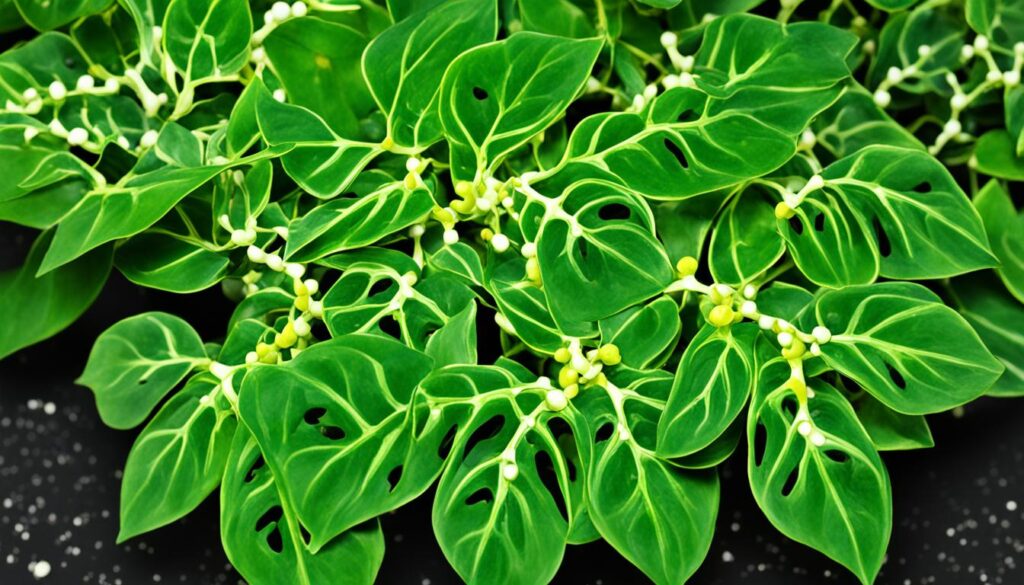
Does philodendron Birkin purify air?
The Birkin philodendron is a beautiful plant in the philodendron family. It’s known for its unique leaves. But, it’s not clear if it can clean the air well. Most houseplants help clean the air, but the Birkin philodendron is more about looking good.
This plant has insoluble calcium oxalates that can be harmful to pets and kids if they eat it. So, it’s best to keep it away from them. This way, it can’t cause any harm.
Some people think plants like the Birkin philodendron clean the air a lot. But, the truth is, they don’t do much for air quality. Real air purifiers or good airflow are much better at cleaning the air.
In short, the Birkin philodendron is pretty but not great at cleaning the air. Always think about safety and take good care of it. This way, it won’t be a problem for your family or pets.
“The Birkin philodendron is a stunning plant, but its air-purifying properties are not its main draw.”
Are philodendrons toxic to touch?
Philodendrons are mostly toxic if eaten, but touching them can also cause skin irritation. The plant has insoluble calcium oxalates that can lead to philodendron skin irritation. This can cause redness, swelling, and itching in some people.
It’s a good idea to wear gloves when taking care of philodendrons to avoid touching the sap or leaves. Washing your hands well after touching the plant is also a good step. This helps reduce the risk of philodendron contact toxicity and lets you safely handle philodendrons.
“Philodendrons contain insoluble calcium oxalates that can cause skin irritation, so it’s best to wear gloves when caring for these plants.”
Philodendrons can also be harmful if eaten by pets. Cats, dogs, and other animals might drool, vomit, or have trouble swallowing if they eat the plant. So, keep philodendrons away from pets and watch them around these plants.
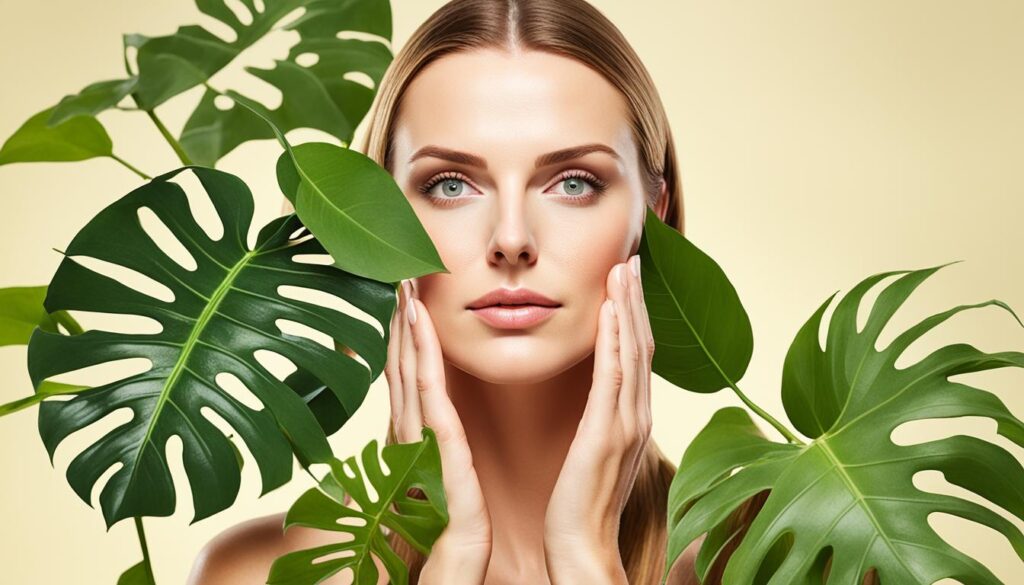
By being careful and knowing about philodendron contact toxicity, you can enjoy these plants safely. Always be cautious when handling philodendrons. If you get any skin irritation or other symptoms, see a doctor right away.
What part of the philodendron is poisonous?
Philodendrons, like the heartleaf and fiddle-leaf, are not safe for cats and dogs. They have insoluble calcium oxalates in every part. These crystals can hurt pets and kids if they eat them.
All parts of the philodendron – leaves, stems, flowers, and roots – are poisonous. So, the whole plant is toxic. Keep it away from pets and kids.
When pets touch or eat the philodendron, they can get hurt. They might have mouth pain, swelling, drooling, vomiting, diarrhea, and trouble breathing.
But, pets usually get better in 24 hours if they don’t eat much. Still, see a vet right away if your pet eats a philodendron.
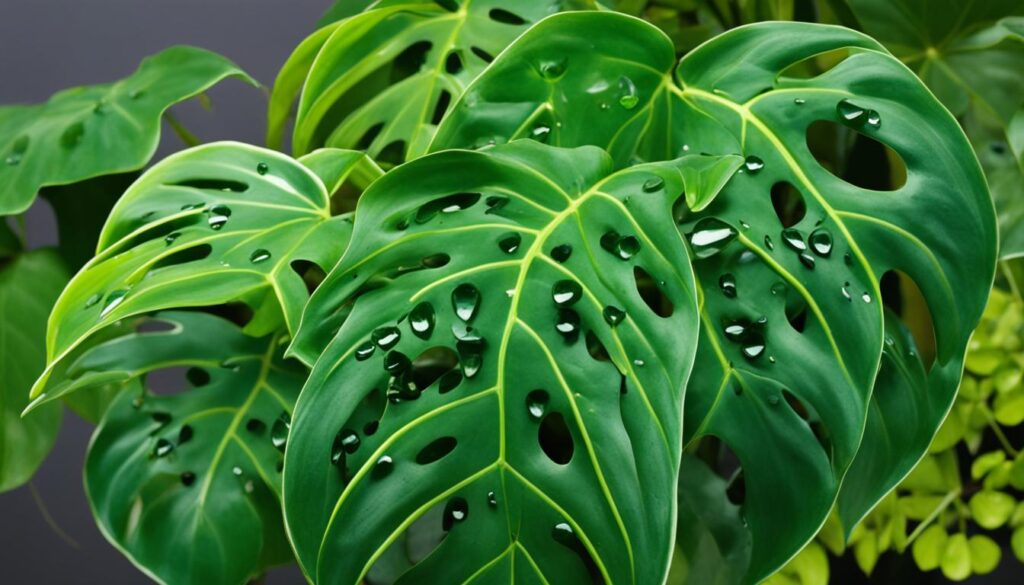
To keep pets safe, remove all philodendrons from your home and yard. Choosing safe plants and making your home safe can help prevent poisonings.
How toxic is philodendron to pets?
Philodendrons are not very safe for pets and can cause serious problems if eaten. The insoluble calcium oxalates in the plant can make pets very sick. They can cause swelling, trouble swallowing, vomiting, and other stomach issues in cats, dogs, and other animals. Even though they’re not as deadly as some other plants, they are still a big risk to pets.
The ASPCA says that all philodendron plants are bad for dogs, cats, and horses. How sick a pet gets from eating philodendron can vary. But, it’s very important to get vet help right away if a pet eats any part of a philodendron.
Cats might show signs like oral irritation, drooling, vomiting, and swelling of the mouth, tongue, and lips from eating philodendron. Dogs could have difficulty swallowing, hoarse barking, swelling of the tongue and lips, vomiting, and diarrhea. Sometimes, pets might not show signs right away, so it’s important to watch them closely.
The philodendron toxicity level for pets is mild to moderate. But, the severity of philodendron poisoning in pets can still be serious. Keeping philodendron plants away from pets and giving them cat grass can help keep them safe.
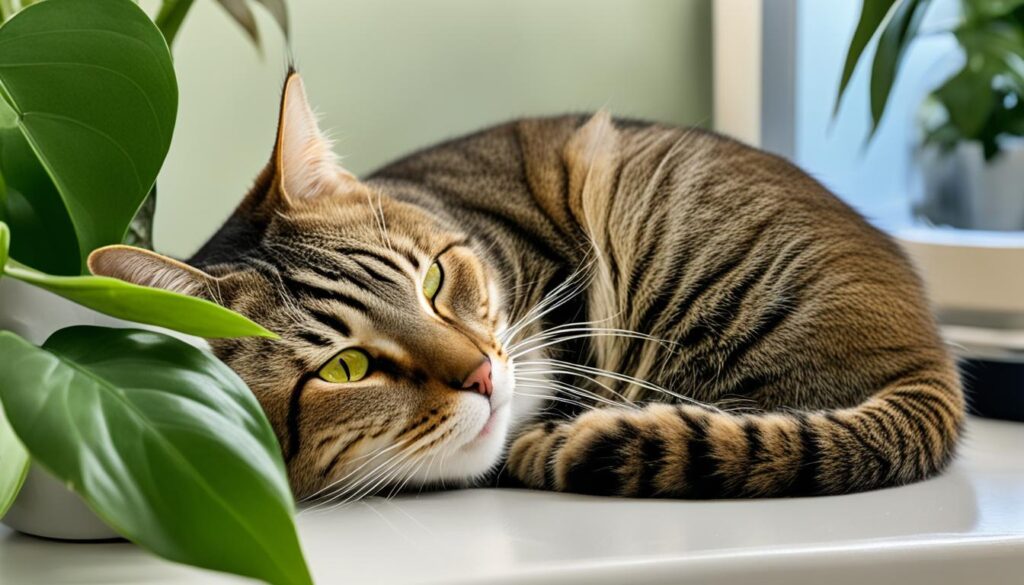
If you think your pet ate a philodendron, call a vet right away. They might do blood tests, urinalysis, and look at what your pet vomited. Treatment could include fluids through a vein, medicine for allergies, stomach protectors, and watching your pet until they get better.
Philodendrons are not as toxic as some plants like Easter Lilies or Sago Palms. But, they are still a big risk to pets. Pet owners should think about safer plants or make sure their pets can’t get to these plants.
Are philodendrons safe for humans?
Philodendrons can be a concern for pets and kids, but they can also be harmful to humans if eaten. The plant has insoluble calcium oxalates that can cause irritation and swelling in the mouth, throat, and stomach. But, serious poisonings from philodendrons are rare in adults, as most people don’t eat the plant on purpose.
It’s wise to keep philodendrons away from curious kids and to avoid touching the plant with your skin. These plants have toxins that can make you feel bad if you eat them. So, be careful with these plants at home.
Philodendrons are moderately toxic to cats and dogs, and they can also be harmful to humans if eaten by mistake. The insoluble calcium oxalates in philodendrons can cause mouth irritation, drooling, and even kidney stones in some cases.
To keep your family safe, make sure to keep philodendrons away from pets and young kids and don’t touch the plant with your skin. By doing this, you can reduce the risks of philodendrons and still enjoy these lovely plants at home.
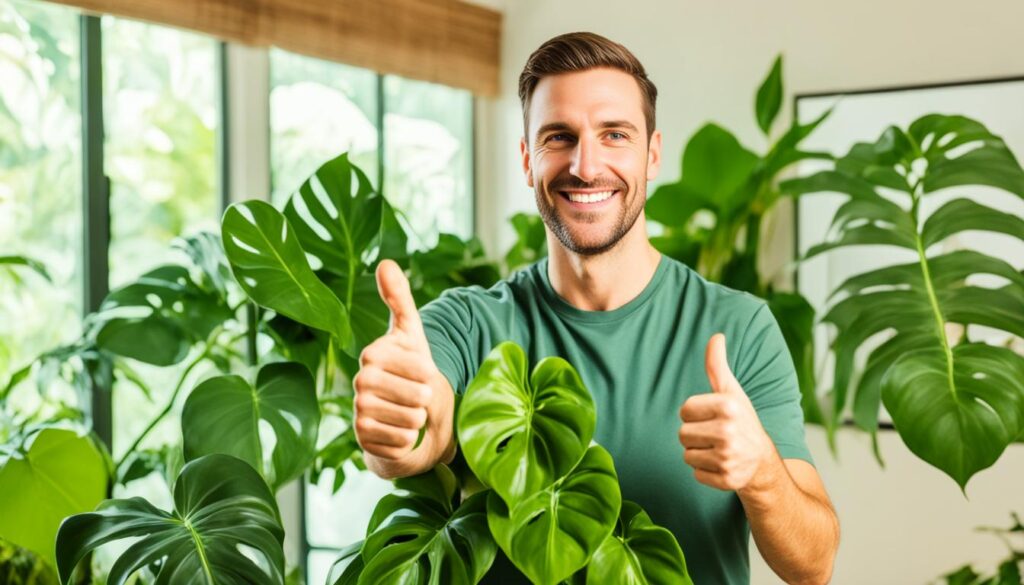
“Philodendrons are only mildly poisonous to pets and won’t typically cause death, but eating any part can lead to discomfort and distress depending on the amount consumed.”
What is the disadvantage of philodendron?
Philodendrons are toxic to pets and kids. They have insoluble calcium oxalates that cause severe reactions if eaten. These reactions include painful swelling, trouble swallowing, and stomach pain. Touching the plant can also irritate the skin.
For homes with pets or young children, philodendrons are not safe. They can cause more harm than good as houseplants.
Philodendrons can be dangerous to pets and kids. Eating any part of the plant can lead to mouth and lip irritation. It can also cause swallowing problems, less appetite, vomiting, and breathing issues in severe cases.
All philodendron types can burn a dog or cat’s mouth and lips. They can also make pets vomit and eat less.
Pet owners should be careful with philodendrons at home. The risks, including serious health problems, are not worth their look. It’s important for pet owners to think about their pets’ safety before adding philodendrons to their homes.
